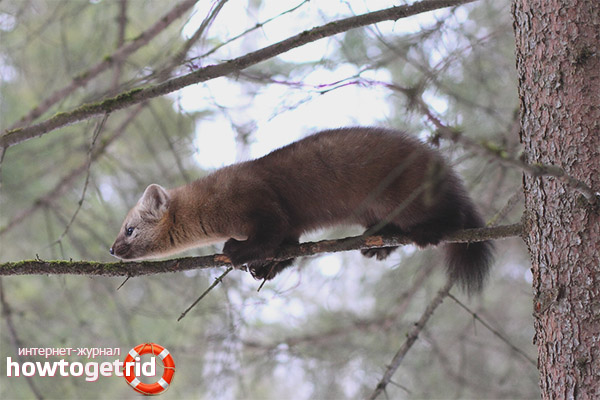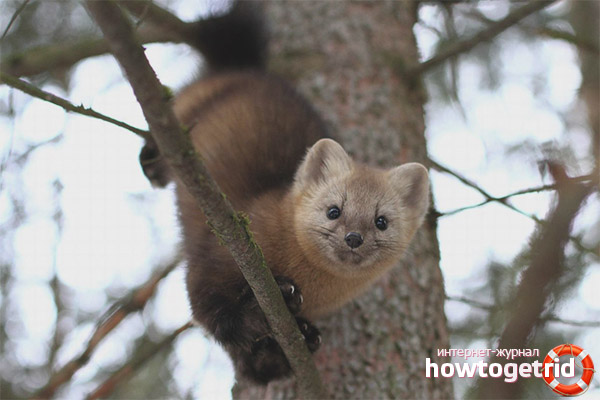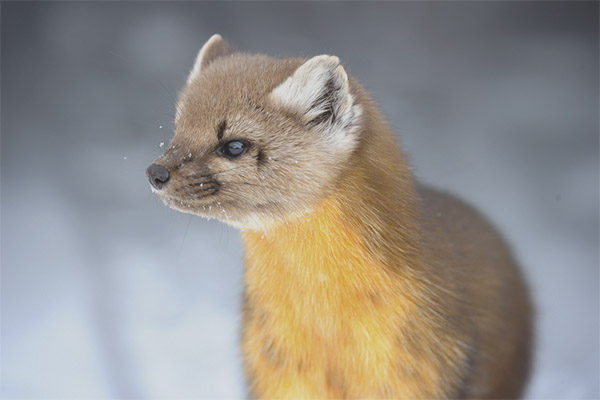The content of the article
Sable is a small mammal predatory animal belonging to the family of weasels. The closest relative of the sable is the pine marten. This cute animal has a slender body, short limbs, bushy tail and sharp claws.
Operation history
Sable is Russia's national pride. Since ancient times, sables are valued for their soft, thick, dark fur, which remains a luxury item to this day. In the Russian fur industry, sable fur occupies one of the main places. Despite the fact that animal hunting is still common in Russia, most of the furs on the market are sold on a commercial basis.
Sable fur from the early middle ages was highly valued in the fur trade. The intensification of hunting in Russia in the 19th and early 20th centuries led to a rather sharp decline in its numbers, therefore in 1935 a five-year ban on hunting for this valuable animal was introduced, and only winter hunting was subsequently allowed.This ban and the formation of sable farms allowed these species to fill most of their previous range and reach healthy quantities by 1990. After the collapse of the Soviet Union, hunting and poaching increased in the 1990s, partly because Russian furs produced in the wild are considered the most luxurious and highly valued on the international market.
Due to the high costs, sable fur is usually integrated into various styles of clothing, for example, to decorate collars, hems, sleeves and caps. The so-called sable brushes used for watercolor or oil painting are not made of sable hair, but from Siberian weasel hair.
Sable description
This is a medium sized animal.Males weighing 880-1800 g, have a body length of 36-57 cm and a tail size of 8-11 cm. Females are slightly smaller than males. Their body length is 34-52 cm, and the length of their tail is 7.3-11 cm. With an elongated body, the sable has short legs, therefore its back is constantly arched. It has a triangular head, which is rather large compared to the body. Its long triangular ears have a wide base, and frame a slightly pointed muzzle.
Fluffy and very thick sable fur is truly its true wealth. In the cold season, the fur becomes more fluffy and covers the paw pads. His paws are quite wide, which allows him to maintain a terrestrial lifestyle.
In the summer, the sable is dark brown in color. At the same time, its paws and tail are much darker. In winter, the sable's fur brightens a bit, its body color becomes sandy or brown. The head is lighter in comparison with the body; in the neck, you can often notice a bright, indefinite spot, which is absent in summer.
Habitats

Sable is most often found in the forests of Siberia, Eurasia, and some areas of the Far East. The fluffy animal now lives in Mongolia and Korea.In Russia, the distribution of sable, to a greater extent, is the result of large reintroductions involving 19,000 animals in the period that lasted from 1940 to the end of 1965. Their range in the north reaches the limit of tree growth, in mountainous regions of East Asia, to 42 latitude. The western distribution of sable covers all the Ural Mountains. On Sakhalin, these furry animals can also be found.
In Mongolia, these animals live in the Altai Mountains, as well as in the forests around Lake Khovsgol, adjacent to the Trans-Baikal forest region, from which the most valuable sable skins are extracted. In China, they are found in Xinjiang Uygursk. In northeastern China, the habitat of sable is confined to the mountains of Dasinganlin. In eastern Heilongjiang, the preservation of sables is observed in the Xiaoingangling Mountains. Individuals also live on the Korean Peninsula.
Since the appearance of sable differs in different geographic areas, there have been some disputes over the exact number of their subspecies, which can be clearly identified. Recognize seventeen different subspecies of sable, but in some scientific sources in recent times can be found from eight to thirty species.
Habitat
These animals live in dense forests, dominated by pine, fir, aspen, cedar, as in the mountain and in the plain area. They protect their native territories, which stretch from 4 to 28 km depending on food and terrain. However, when food is scarce, they can move in search of food over great distances, while the speed of movement is 5 to 13 km per day.
The most favorite habitat of their habitats are taiga thickets. Damp, dark coniferous forests are the favorite habitats of sable. Attract this animal hard to reach places with a large number of branches. It seems that this is the instinct for the self-preservation of this animal, which is trying to defend itself against enemies in this way.
Sables also live in burrows in the densest parts of the forest and on the banks of rivers. Their burrows usually become safer if they are dug among the numerous roots of trees. They perfectly move through the trees and rocky terrain.
Lifestyle

These are twilight animals that love to hunt at dusk. They become much more active during the day during the mating season.Sable burrows are perfectly hidden from outsiders. They are lined with grass and wool, but are often temporary shelters, especially in winter, when the sables have to travel in search of food.
They hunt mostly with the help of their sense of smell and keen hearing. The animal's vision is developed slightly weaker than hearing and smelling, but this does not really harm the animal's nightly hunt. In various situations, these small animals make different interesting sounds. Basically it is a quiet rumbling, gentle, reminiscent of a cat's meow in the mating season, as well as a loud crackling in a period of danger. Sables mark their territory with the aroma produced in the glands on the stomach. A number of larger predators threaten Sobol: bears, lynxes, wolves and tigers.
In nature, sable is valued by the fact that it controls the number of small mouse-like rodents.
Nutrition
Sables are omnivores, and their diet varies seasonally. In the summer, they may feed on hares, mice, or other small mammals. In the cold season, when their diet restricts frost and snow, they eat wild berries, mice, rabbits and even small musk deer.Sometimes, they follow in the footsteps of bears or wolves to feed on the remains of their prey.
They hunt for small birds, weasel and ermine. They also feed on mollusks, which they rub on the ground to remove mucus. With their front paws, they can catch a fish that they eat later. Sable can also eat a variety of plant foods. Various fruits, berries and nuts are a favorite delicacy of sable. He easily finds in the winter, under a thick layer of snow, the remaining berries from the autumn.
Breeding sable

Usually mating of sables occurs in the summer from June 15 to August 16. Date depends on the habitat. Males dig meter shallow grooves in the snow, often accompanying it with urination. During courtship, sables jump, run and “purr” like cats. They fiercely fight each other for the favor of females. Fighting for leadership is a fairly common occurrence for these beautiful animals.
Females enter estrus in the spring. Mating sometimes lasts up to 8 hours. After insemination of the female, the blastocyst is not immediately implanted in the uterine wall. Only in 8 months implantation occurs; the fetal development of the fetus takes only a month, although the pregnancy lasts up to 297 days,
Babies are born in the hollows of large trees in which sables make nests consisting of dried grass and fallen leaves. A female can give birth to 1 to 7 babies, although the birth of 2 or 3 calves is most common. Males help females at this time. They provide them with food and very carefully protect their territory.
Sables can sometimes interbreed with pine martens. This can be observed in the forests of the Ural Mountains, where these 2 species intersect, it is sometimes intentionally done on fur farms. The resulting hybrid, called kidus, is slightly smaller than pure sable. His fur is much rougher, but otherwise he has a similar color and fluffy long tail. Kidus is usually sterile. Although one case was recorded when a female Kidus successfully bred with a male pine marten.
Sable can be easily tamed.By his behavior he resembles a domestic cat. The animal can very quickly get used to the person. Today, sables are bred on farms. In such artificial conditions even very rare species of black sables are bred. The value of sable fur is determined by its color and softness. The most expensive is dark fur.
Video: Sable (Martes zibellina)











To send